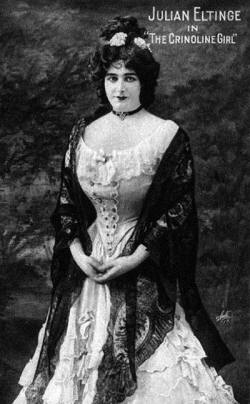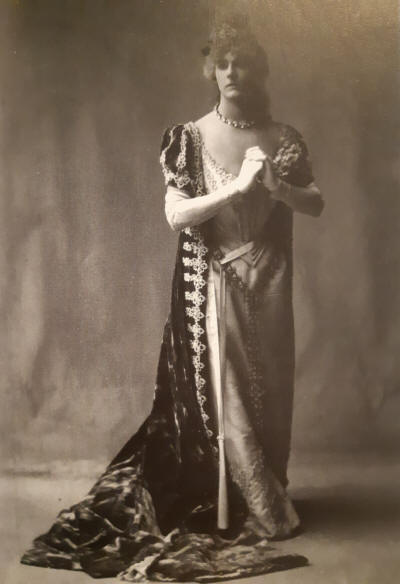

Queer Places:
AMC Empire 25, 234 W 42nd St, New York, NY 10036
Forest Lawn Memorial Park (Glendale) Glendale, Los Angeles County, California, USA, Plot Great Mausoleum, Columbarium of Rest, Niche 7310
 Julian Eltinge (May 14, 1881 – March 7, 1941), born William
Julian Dalton, was an American
stage and screen actor and
female impersonator. After appearing in the
Boston
Cadets Revue at the age of ten in feminine garb, Eltinge garnered notice from
other
producers and made his first appearance on
Broadway in 1904. As his star began to rise, he appeared in
vaudeville and toured Europe and the
United States, even giving a
command performance before King
Edward VII. Eltinge appeared in a series of
musical comedies written specifically for his talents starting in 1910
with
The Fascinating Widow, returning to vaudeville in 1918. His popularity
soon earned him the moniker "Mr.
Lillian Russell" for the equally popular
beauty and
musical comedy star.
Julian Eltinge (May 14, 1881 – March 7, 1941), born William
Julian Dalton, was an American
stage and screen actor and
female impersonator. After appearing in the
Boston
Cadets Revue at the age of ten in feminine garb, Eltinge garnered notice from
other
producers and made his first appearance on
Broadway in 1904. As his star began to rise, he appeared in
vaudeville and toured Europe and the
United States, even giving a
command performance before King
Edward VII. Eltinge appeared in a series of
musical comedies written specifically for his talents starting in 1910
with
The Fascinating Widow, returning to vaudeville in 1918. His popularity
soon earned him the moniker "Mr.
Lillian Russell" for the equally popular
beauty and
musical comedy star.
In 1911, Eltinge opened on Broadway in a musical-play, The Fascinanting Widow. This was followed by The Crinoline Girl (1914) and Cousin Lucy (1915). All of these plays, like Eltinge's later movies, had the plot requirement of a man dressing as a woman. Touring domestically and internationally, the shows made Eltinge so rich and famous that a Broadway theater was built and named after him. It still stands on 42nd Street, New York, now called the Empire.
Hollywood beckoned Eltinge and in 1917 he appeared in his first feature film, The Countess Charming. This would lead to other films including 1918s The Isle of Love with Rudolph Valentino and Virginia Rappe. By the time Eltinge arrived in Hollywood, he was considered one of the highest paid actors on the American stage; but with the arrival of the Great Depression and the death of vaudeville, Eltinge’s star began to fade. He continued his show in nightclubs but found little success. He died in 1941 following a show at a New York City nightclub. He leaves a legacy as one of the greatest female impersonators of the 20th century.
Aside from the graceful femininity he exhibited onstage, Eltinge used a super-masculine facade in public to combat the rumours of his homosexuality. This facade included the occasional bar-fight, smoking cigars, and drawn out engagements to women (though he never married). He was also known to physically attack stagehands, members of the audience and others who remarked on his sexuality. Indeed, his sexual duality led to Dorothy Parker's creation of the term "ambisextrous" to describe him.[3]

Eltinge may have been a gay man,[4] as Milton Berle and many others who worked with him believed. Actress Ruth Gordon stated in a New York Times article that he was "as virile as anybody virile." There is no existing record of a lover of either sex, though stories did abound.
According to one such story recorded by Robert Toll in his book On With the Show! (1976), he gave a photograph of himself as Salomé, signed "From your friend Jule", to a Boston sportswriter. When the sportswriter's wife discovered the photograph in her husband's coat pocket she was outraged. Confronting her husband, she had to be convinced that the "woman" in the photograph was actually a man, and then was disturbed to find that her husband had been spending time with him.
Eltinge was one of many show business figures to be hit hard by the 1929 stock market crash. By the 1930s, the female impersonations that he had built his career on had begun to lose popularity, as did vaudeville in general. He had grown portly and unable to portray the svelte young female roles of his heyday. Eltinge resorted to performing in nightclubs. Crackdowns on cross-dressing in public, a misguided attempt to curb homosexual activity, prevented Eltinge from performing in costume. At one appearance in a Los Angeles club, Eltinge stood next to displays of his gowns while describing his old characters.
On February 25, 1941, Eltinge fell ill while performing at Billy Rose's Diamond Horseshoe nightclub.[5] He was taken home and died in his apartment ten days later on March 7. His death certificate lists the cause of death as a cerebral hemorrhage.
My published books: